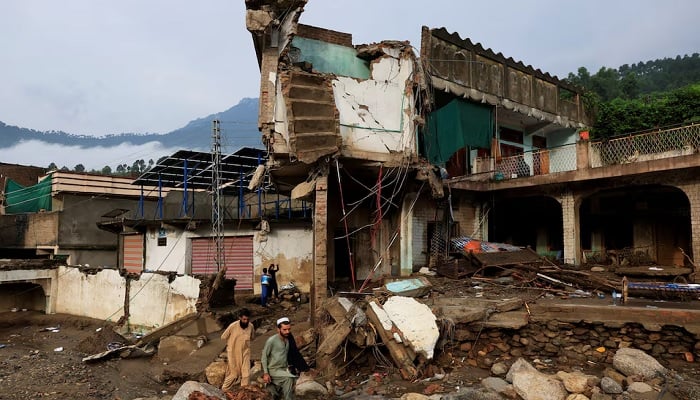Headmaster’s quick action saved nearly 1,000 students in Swat’s Mangalore area after flash floods ripped through their government primary school, bringing down the walls and classrooms in the aftermath of torrential rains in Khyber Pakhtunkhwa.
Rescuers dug homes out from under massive boulders on Sunday as they searched for survivors of flash floods after severe flash floods in northern Pakistan, as rain-related deaths nationwide — mostly in KP, Gilgit-Baltistan and Azad Jammu and Kashmir — crossed the grim 300 mark.
Torrential rains across the country since Thursday have caused flooding, rising waters and landslides that have swept away entire villages and left many residents trapped in the rubble.
Headmaster Saeed Ahmed told Geo News that the morning the flood struck, he noticed the water level in a nearby stream rising rapidly.
Without wasting a moment, he ordered his teachers to immediately send the children home.
Minutes later, the floodwater surged into the school, toppling its boundary wall and filling classrooms and offices.
In just five minutes, the entire school was submerged.
But by then, every one of the 936 students had been safely moved out. Not a single life was lost.
Ahmed’s presence of mind saved an entire school from turning into a tragedy.
Standing among the ruins of the building, he appealed to the government to act swiftly and rebuild so that children can return to their studies.
Mass funerals
On Saturday, hundreds gathered for mass funerals, where bodies wrapped in blood-stained white shawls were laid out on the village ground.
Fallen trees and straw debris were scattered across nearby fields, while residents shovelled mud out of their homes.
The country’s meteorological department has forecast “torrential rains” with monsoon activity “likely to intensify” from Sunday onwards.
Iran said it stood ready to provide “any cooperation and assistance aimed at alleviating the suffering” in neighbouring Pakistan, while Pope Leo XIV addressed the flooding with prayers “for all those who suffer because of this calamity”.
Monsoon, bane and bone
The monsoon season brings South Asia about three-quarters of its annual rainfall, vital for agriculture and food security, but also brings destruction.
“The intensity of this year’s monsoon is around 50 to 6% more than last year,” said Lieutenant General Inam Haider, chairman of the national disaster agency.
“Two to three more monsoon spells are expected until the first weeks of September,” he told journalists in Islamabad.
Landslides and flash floods are common during the season, which usually begins in June and eases by the end of September.
The torrential rains that have pounded Pakistan since the start of the summer monsoon have killed more than 650 people, with more than 920 injured.
Pakistan is one of the world’s most vulnerable countries to the effects of climate change and is contending with extreme weather events with increasing frequency.
Monsoon floods in 2022 submerged a third of the country and killed around 1,700 people.


